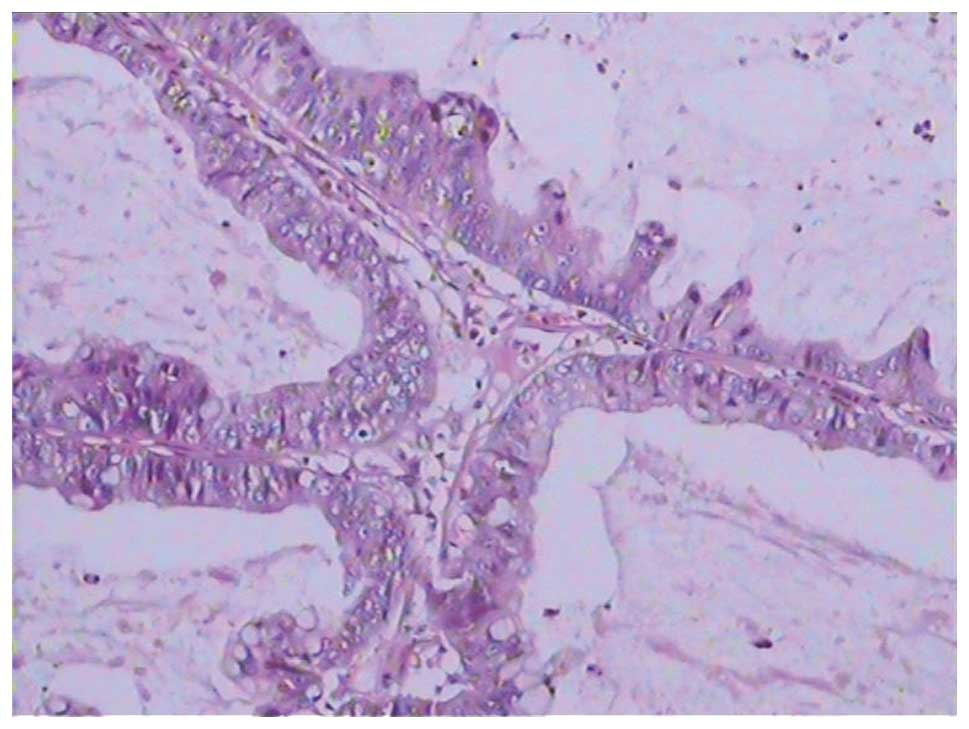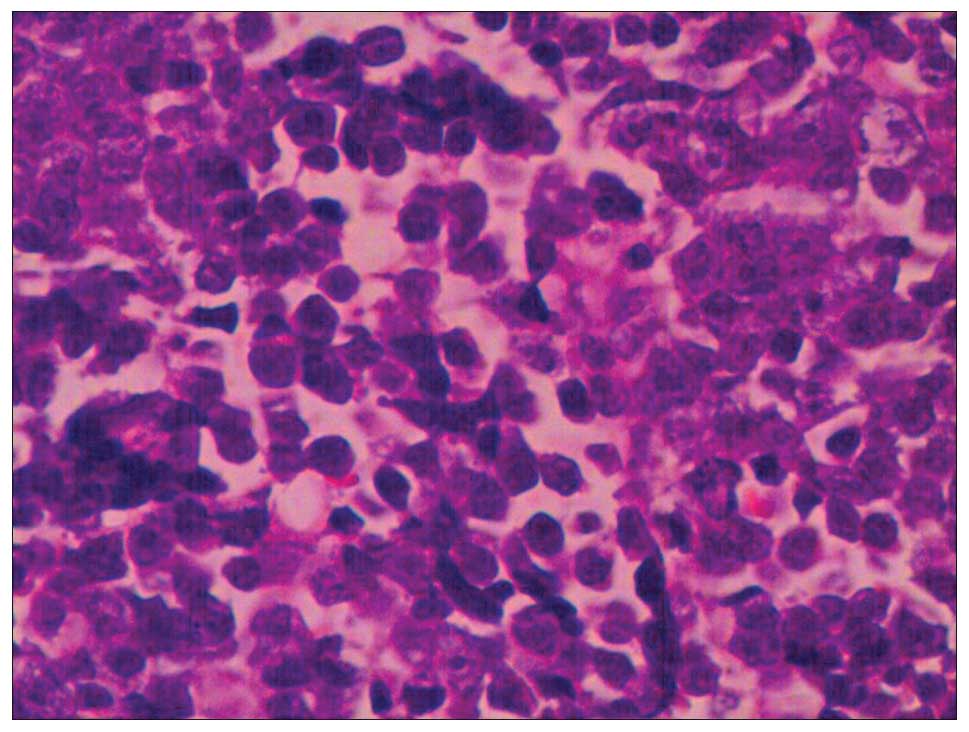Ovarian cancer transformation from adenocarcinoma to undifferentiated small cell carcinoma: A case report
- Authors:
- Published online on: March 12, 2015 https://doi.org/10.3892/ol.2015.3031
- Pages: 2230-2232
Abstract
Introduction
It is widely accepted that the histology of ovarian cancer does not change in a patient. However, cancer stem cells (CSCs) are the origin of numerous tumors (1). Ovarian CSCs form spheroids and multicellular colonies that differentiate along epithelial, granulosa and germ cell lineages in vivo (2). CSCs have been shown to exist in ovarian carcinomas, and the expression of cluster of differentiation (CD)44, c-Kit and CD133 have been detected in these tumors (1). It appears that the histology of ovarian cancer would be change in the period of therapy with CSCs existing. To the best of our knowledge, no studies currently exist regarding the transformation of ovarian cancer from one histology into another. In the present study, the ovarian cancer transformed from adenocarcinoma into undifferentiated small cell carcinoma, supporting the hypothesis that CSCs can differentiate into different types of mature neoplastic cells.
Case report
A 27-year-old female presented to The Affiliated Wujing Hospital of Guangzhou Medical College (State Key Laboratory of Respiratory Disease, Guangzhou, Guangdong, China) with an abdominal mass in April 2011. Computed tomography (CT) revealed a large intraperitoneal cystic mass and ascites. The patient presented with abdominal pain, but no fever. Complete blood count, and liver and renal function test results were normal. An ascites sample obtained by abdominocentesis tested positive for adenocarcinoma. The patient underwent surgery in June 2011, and multiple pelvic nodules, a large intraperitoneal cystic mass with ovarian involvement and an abdominal peritoneal implant, measuring 1.0 cm in diameter, were found. The inguinal and retroperitoneal lymph nodes were negative for cancer cell invasion. The pathological analysis of the mass indicated moderately-differentiated adenocarcinoma (Fig. 1). The patient was diagnosed with ovarian cancer, stage IIIb T3bN0M0, according to the International Federation of Gynecology and Obstetrics staging system (1988) (3). The patient was treated with combination chemotherapy consisting of platinum and paclitaxel. This chemotherapy regimen involved the administration of placlitaxel (120 mg, i.v.) followed by platinum (120 mg) every three weeks for six cycles. The treatment outcome was evaluated as a partial response after 18 weeks. The abdominal mass recurred, and the patient underwent surgery in June 2012. The pathology of the mass indicated a poorly-differentiated adenocarcinoma in February 2012 (Fig. 2). The ovarian carcinoma cells were negative for CD133 expression. The patient was treated with two cycles of gemcitabine-paclitaxel chemotherapy. Tumor biopsy results indicated an undifferentiated small cell carcinoma and positive CD133 expression in the ovarian carcinoma cells (Figs. 3 and 4). Positron emission tomography-CT revealed evidence of extensive metastatic disease in the neck, thoracic lymph nodes and liver, nodules along the diaphragm, and multiple pelvic nodules (Fig. 5). Whole abdomen irradiation was administered at a dose of 46 Gy (23 fractions) in May 2012, however, the patient succumbed to the disease in September 2012.
Written informed consent was obtained from the patient's parents for publication of this study. The study was approved by the Ethics Committee of the Affiliated Wujing Hospital of Guangzhou Medical College.
Discussion
Histologically, ovarian neoplasms are epithelial tumors, germ cell tumors, sex cord stromal tumors and other tumors with the same underlying characteristics, and the histology does not change. Stem cells have the potential for multidifferentiation and proliferation, and can differentiate into various types of tissues, such as adipocytes, osteocytes and chondrocytes (4).
It is widely accepted that neoplastic stem cells can differentiate into different types of mature neoplastic cells. Multifactorial mechanisms for network formation result in tumorigenesis in cancers and sarcoma by the activation or deactivation of signaling pathways (5,6). In the present study, the pathology indicated a change from moderately-differentiated adenocarcinoma to poorly-differentiated adenocarcinoma, and to undifferentiated small cell carcinoma. The expression of CD133 changed from negative to positive in the ovarian carcinoma cells. This indicated that the ovarian carcinomas possessed high proliferative potential and clonogenic efficiency, with stem-like characteristics.
We hypothesize that neoplastic stem cells can differentiate into several types of mature neoplastic cells, with synaptophysin as a marker for adenocarcinoma, small cell cancer and undifferentiated carcinoma, following chemotherapy. Tumor cells exhibit potential directional differentiation from one type of cell to another through cell transformation induced by cell signaling pathway activation or deactivation (2). This finding is supported by the previously reported dedifferentiation of mature goblet cells elicited by Wnt/β-catenin pathway activation (7).
If a signal pathway is terminated or weakened by medicine or other interventions, such as pre-operative chemotherapy, radiation, its impaired function would be replaced by other signaling pathways (8). This is a likely cause of the change in malignant pathological type following treatment. In the present study, the mass was complete resected by surgery and no residual tumor tissue was left. The biopsy results showed a different pathology at all incidences of tumor progression following surgery or the different chemotherapy regimens. Considerable evidence supports the ability of neoplastic stem cells to differentiate into various types of mature tumor cells (1).
It is tempting to speculate that chemotherapy may result in differentiation into one particular type of mature tumor cell, which could lead to a shift in the phenotypical appearance. The neoplastic stem cell genotype and phenotype may evolve dynamically under the selective pressure of pre-operative chemotherapy, radiation, and targeted therapy (2).
In the present study, the malignancies exhibited pathological changes following chemotherapy. This finding is supported by previous observations of chemotherapy-resistant tumors that transformed from non-small cell lung cancer (NSCLC) into SCLC (9), which was attributable to a genetic or epigenetic event that concurrently led to a shift in phenotypic appearance. To the best of our knowledge, the genetic resistance to epidermal growth factor receptor (EGFR) tyrosine kinase inhibitors has persisted, as EGFR genetic mutations resulted in the transformation of NSCLC to SCLC (10,11).
The present study indicated that epithelial tumors, germ cell tumors, sex cord stromal tumors and other tumors may histologically originate from neoplastic stem cells in ovarian neoplasms. This study also demonstrates the importance of repeatedly checking the appropriate therapy by tumor biopsy throughout the course of ovarian cancer progression.
References
|
López J, Valdez-Morales FJ, Benítez-Bribiesca L, Cerbón M and Carrancá AG: Normal and cancer stem cells of the human female reproductive system. Reprod Biol Endocrinol. 11:532013. View Article : Google Scholar : PubMed/NCBI | |
|
Bapat SA, Mali AM, Koppikar CB and Kurrey NK: Stem and progenitor-like cells contribute to the aggressive behavior of human epithelial ovarian cancer. Cancer Res. 65:3025–3029. 2005.PubMed/NCBI | |
|
Shepherd JH: Revised FIGO staging for gynaecological cancer. Br J Obstet Gynaecol. 96:889–892. 1989. View Article : Google Scholar : PubMed/NCBI | |
|
Zhang H, Zhang B, Tao Y, Cheng M, Hu J, Xu M and Chen H: Isolation and characterization of mesenchymal stem cells from whole human umbilical cord applying a single enzyme approach. Cell Biochem Funct. 30:643–649. 2012. View Article : Google Scholar : PubMed/NCBI | |
|
Yang X, Takano Y and Zheng HC: The pathobiological features of gastrointestinal cancers (Review). Oncol Lett. 3:961–969. 2012.PubMed/NCBI | |
|
Bosland MC: Sexsteroids and prostatecarcinogenesis: integrated, multifactorial working hypothesis. Ann NY Acad Sci. 1089:168–176. 2006. View Article : Google Scholar : PubMed/NCBI | |
|
Finch AJ, Soucek L, Junttila MR, Swigart LB and Evan GI: Acute overexpression of Myc in intestinal epithelium recapitulates some but not all the changes elicited by Wnt/beta-catenin pathway activation. Mol Cell Biol. 29:5306–5315. 2009. View Article : Google Scholar : PubMed/NCBI | |
|
Fu W, Madan E, Yee M and Zhang H: Progress of molecular targeted therapies for prostate cancers. Biochim Biophys Acta. 1825:140–152. 2012.PubMed/NCBI | |
|
Sequist LV, Waltman BA, Dias-Santagata D, Digumarthy S, Turke AB, Fidias P, Bergethon K, Shaw AT, Gettinger S, Cosper AK, Akhavanfard S, Heist RS, Temel J, Christensen JG, Wain JC, Lynch TJ, Vernovsky K, Mark EJ, Lanuti M, Iafrate AJ, Mino-Kenudson M and Engelman JA: Genotypic and histological evolution of lung cancers acquiring resistance to EGFR inhibitors. Sci Transl Med. 3:75ra262011. View Article : Google Scholar : PubMed/NCBI | |
|
Zakowski MF, Ladanyi M and Kris MG: Memorial Sloan-Kettering Cancer Center Lung Cancer OncoGenome Group: EGFR mutations in small-cell lung cancers in patients who have never smoked. N Engl J Med. 355:213–215. 2006. View Article : Google Scholar : PubMed/NCBI | |
|
Tatematsu A, Shimizu J, Murakami Y, Horio Y, Nakamura S, Hida T, Mitsudomi T and Yatabe Y: Epidermal growth factor receptor mutations in small cell lung cancer. Clin Cancer Res. 14:6092–6096. 2008. View Article : Google Scholar : PubMed/NCBI |














